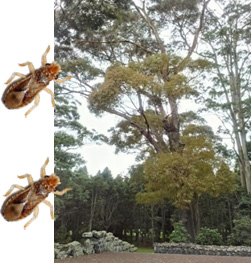PESTS AND DISEASES OF FORESTRY IN NEW ZEALAND
Bronze Bugs on the move
Scion is the leading provider of forest-related knowledge in New Zealand
Formerly known as the Forest Research Institute, Scion has been a leader in research relating to forest health for over 50 years. The Rotorua-based Crown Research Institute continues to provide science that will protect all forests from damage caused by insect pests, pathogens and weeds. The information presented below arises from these research activities.
From Forest Health News 276, October 2017.

Bronze bug (Thaumastocoris peregrinus), the sap-sucking Eucalyptus spp. pest is on the move. Scion entomologist Toni Withers has now recorded bronze bug in Tauranga, extending its range in the North Island significantly east from its previous records in Cambridge (apart from an isolated population in Napier). Bronze bug was first recorded in New Zealand in March 2012 and has been dispersing relatively slowly in New Zealand (see FH News 233 for more details). It causes the characteristic ‘bronzing’ of all or parts of tree foliage it is infesting. Usually this symptom is most obvious in the autumn and winter but the FH news editors are interested in any finds of this species north of Auckland and south of Cambridge.
Andrew Pugh
This information is intended for general interest only. It is not intended to be a substitute for specific specialist advice on any matter and should not be relied on for that purpose. Scion will not be liable for any direct, indirect, incidental, special, consequential or exemplary damages, loss of profits, or any other intangible losses that result from using the information provided on this site.
(Scion is the trading name of the New Zealand Forest Research Institute Limited.)

 Farm Forestry New Zealand
Farm Forestry New Zealand

